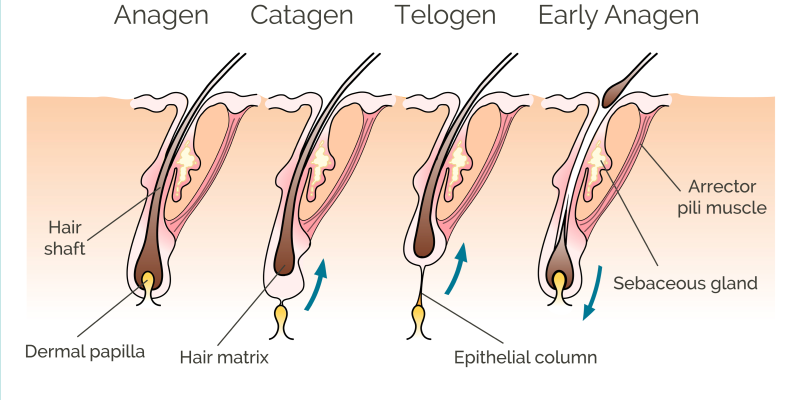
Hair Growth Cycle
Hair growth and loss may appear to be a straightforward process, but the hair growth cycle is actually divided into four separate phases. These stages of hair growth have been extensively researched to better understand how hair grows and what may be done to prevent or treat premature hair loss.
There are many stages of hair development. Each stage has its own schedule, which can be influenced by factors like age, diet, and general health. These factors also affect the average hair growth rate. That means there are things you can do along the process to assist guarantee your hair grows in a healthy manner.
1. Anagen: Growing Phase
The anagen phase is the first stage of hair development. It is the longest phase, lasting roughly 3 to 5 years for the hairs on your head, yet a single hair may continue to grow for 7 years in certain people. Fortunately, the anagen period varies amongst hair types. During the anagen phase, your hair follicles produce hairs that will grow until they are clipped or reach the end of their lives and fall out.
2. Catagen: Transition Phase
The catagen phase begins when the anagen phase ends and lasts roughly 10 days. Hair follicles atrophy and hair development slow during this chapter. The hair also splits from the hair follicle's bottom. At any given moment, only around 5% of the hairs on your head are in the catagen phase.
3. Telogen: Resting Phase
The telogen period usually lasts 3 months and affects around 10% to 15% of your scalp hairs. Hair does not grow during the telogen period, but it also does not fall off. In addition, new hairs begin to grow in follicles that have recently produced hairs during the catagen phase during the telogen phase.
4. Exogen: Shedding Phase
The exogen phase of hair development is simply an extension or component of the telogen stage. Hair is lost from the scalp during the exogen phase, which is typically aided by washing and combing. It is common to lose 50 to 100 hairs every day throughout the exogen period. During the exogen phase, which can last between 2 and 5 months, new hairs develop in the follicles while old hairs fall out.
Delayed Growth After A Hair Transplant
Here is how the hair transplant timeline takes place: Typically, all the transplanted hair is lost in an effluvium and enters a resting period after a transplant. Assume that an FUE slow growth is a novel phenomenon associated with the implantation of extremely tiny hair grafts. In such instances, the hair development cycle in tiny grafts may react differently to the shock of transplanting than those in bigger grafts. In other words, the desiccation, temperature change, and mechanical damage to which tiny grafts may be more susceptible induce a delay in development in circumstances when the follicle was not entirely destroyed. Of course, if you want to learn how to speed up hair growth after the hair transplant, you should consult your doctor before applying any method.
Shedding hair is a normal part of the hair cycle. However, if you see a significant amount of hair fall, it may be a good idea to consult your doctor. When you contact an Asmed professional about your hair loss problem, the fundamental cause of your hair loss will be thoroughly examined, and the Asmed staff will assist you in developing a treatment plan for hair regeneration. If you have any questions or worries about hair growth, hair loss or FUE hair transplant please contact us.